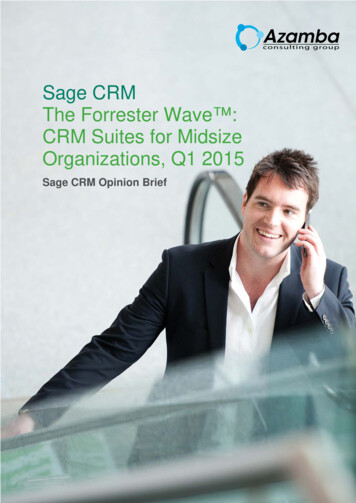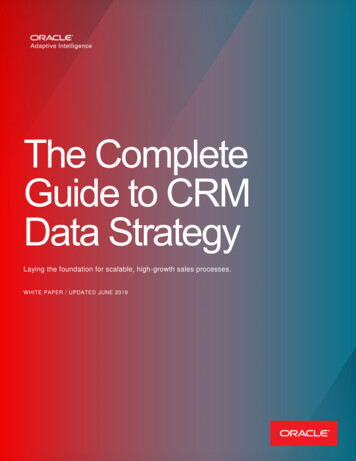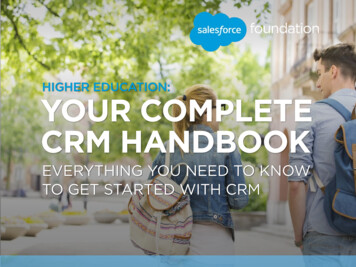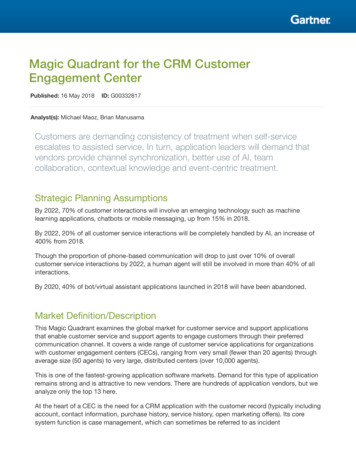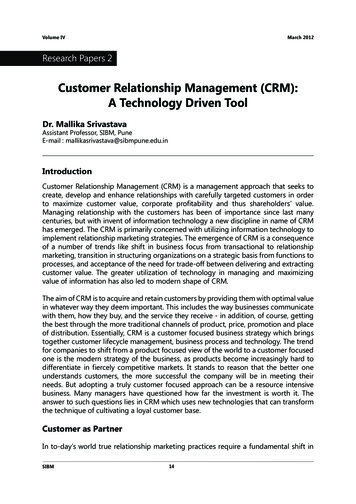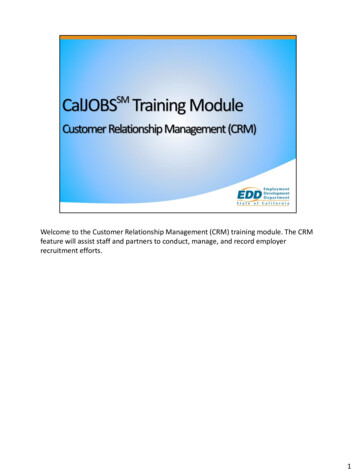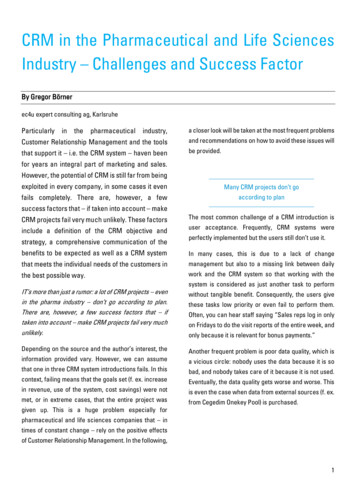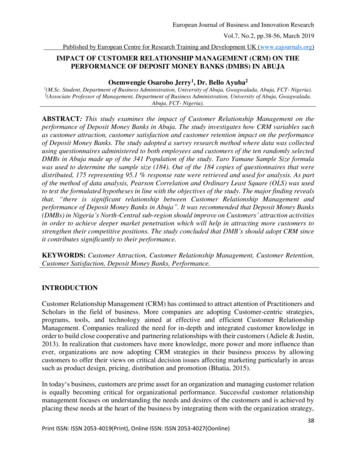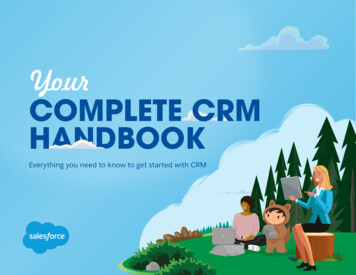
Transcription
YourCOMPLETE CRMHANDBOOKEverything you need to know to get started with CRM
ContentIntroduction. 3Signs You Need a CRM. 4How CRM Improves Productivity. 6How to Craft a CRM Strategy. 10Maximising Your ROI. 12Conclusion. 14Useful Resources. 152Your Complete CRM Handbook
IntroductionCRM is much more than a buzzy acronym that’s been tossed around the business andsales world for over 15 years.C-R-M stands for “Customer Relationship Management”CRM essentially refers to systems specifically designed to manage your customerinformation and interactions. The purpose of CRM is to establish long-lastingrelationships with your customers which in turn drives business growth throughcustomer loyalty.CRM apps simply manage your customer information so you can see it all in one place.You can view contact info, follow-up via email and social media, manage tasks, andtrack performance. There is no secret formula, yet implementing the right CRM canincrease sales efficiency, boost sales, and improve forecast accuracy.Is it time to invest in CRM?The contents of this eBook will help you determine if it is time your business investsin a CRM solution. Over the next four chapters, we will examine the following topics: Signs your business needs CRM How CRM can improve your sales and productivity Building your CRM strategy How to maximise your ROIFirst up, the 6signs your businessneeds a CRMFirst up, the six signs your business needs a CRM.3Your Complete CRM Handbooksalesforce.com
CHAPTER 1Signs You Need a CRMBusinesses typically begin with a basic seller-to-customer relationship.In the early stages, it is often enough to simply maintain an Excelspreadsheet with notes about customers and incoming orders.However, as your business grows, such record-keeping won’t be ableto do what you need anymore and will slow you down. Here are someindicators that it might be time to trade in your early processes andstart managing your customer relationships more effectively:1There’s no single source for information2There’s little or no visibility4Storing your customer and order info in more than one location- such as a spreadsheet or notes stuck to your computer - putsyour sales team at a disadvantage. They lack a single view ofevery customer’s contact info, orders, and interactions, whichcan be time-consuming and disorganised. This in turn affectsproductivity and hinders collaboration.Not only do you lack visibility into how your customers areconnecting with employees, but you also lose track as to whatyour salespeople are doing. This makes it difficult to help thembe successful and keep them accountable.Your Complete CRM HandbookWhen your business thrives,spreadsheets are no longerenough to run your business.salesforce.com
CHAPTER 1 - SIGNS YOU NEED A CRM3Reports are hard to create and shareGenerating reports and analytics of your sales team’s monthlyprogress is ideal, but creating reports manually is cumbersomeand often results in no tracking at all.45Interested parties are not differentiated according to their valueto the company. Instead, all customers and prospects receivethe same offers and information – regardless as to which phaseof the buying process they are in and which industry and regionthey belong to.You don’t have a mobile solutionIn recent times, working from home has become the norm.Your sales reps will be communicating with potential customersand obtaining valuable information away from the office.However, if this new data is stored on personal computer filesand handwritten notes and is not properly transferred, the restof the sales team will not be up to date on important details.These notes can also be easily lost - especially if an employeeleaves the company.All customers are given the same priority6You don’t have a plan to support growthWhat if your business was to grow from 20 to 200 customers thisyear? Are you confident that your current processes can supportsuch growth? If you know that your business will grow and youare worried about keeping up, don’t stress. This is exactly thetype of issue that a CRM system can address.Next up, let’s look at howa CRM makes your businessmore productive.5Your Complete CRM Handbooksalesforce.com
CHAPTER 2How CRM Improves ProductivityThe saying “there never seem to be enough hours in theday” is well known in the sales world, where time quiteliterally equals money. According to our third edition of theSmall and Medium Businesses Trends Report, lack of timeis the main constraint for SME decision makers in the UK.The more effectively and efficiently you use your time, the better it isfor your business. With a combination of a steady flow of new prospects,an increase in time spent selling, and arming sales reps with the info theyneed to close deals more quickly, small businesses can grow rapidly.CRM applications enable exactly this.123Top Factors Constraining BusinessActivities*Insufficient timeHiring the right talentMoney/access to capital* Source: Small & Medium Business Trends Report6Your Complete CRM Handbooksalesforce.com
CHAPTER 2 - HOW CRM IMPROVE S PRODUC TIVIT YSales PipelineSelling TimeFinding time to bring in a steady flow of new customers can be quite achallenge for a small business sales team. This is often caused by issuessuch as:Sales representatives need time to sell. Some of the time traps faced bysalespeople are hard to overcome, but others can be easily fixed: Inability to direct leads to the appropriate sales rep Lack of information on potential clients Inadequate knowledge about a prospect before calling Poor visibility and forecasting of the future pipelineA CRM allows sales reps to store the data on prospects to ensurerelevant information is ready at each interaction along the customerpurchase process. Plus, it quickly provides metrics related to visibilityand forecasting. Automation of repetitive tasks gives salespeople more time toconcentrate on closing deals. Providing one channel for reps to share information and connecteliminates endless email loops and phone tags. Making the switch to mobile can eliminate downtime andincrease communication, which is a big challenge for a salesteam on the go.The right CRM system syncs with mobile devices anywhere, anytimevia the cloud, so the entire team has the most current information attheir fingertips.A cloud-based CRMtool allows your salesteam to keep track ofall interactions withprospects and customersand to have access tothis data at any time.7Your Complete CRM Handbooksalesforce.com
CHAPTER 2 - HOW CRM IMPROVE S PRODUC TIVIT YBetter IntelligenceCompanies that embrace AI will be able to create modern experiencestheir customers expect. For the first time, businesses have access tothe analytics, computing power, and data that will transform how theyapproach their customer relationships. AI will help discover criticalinsights about customers and their preferences, predict the best actionsto move relationships forward, and recommend and automate actionsto increase sales productivity.So, what does AI for CRM look like? Imagine being able to capturereal-time signals, wherever they occur — from a customer’s supportrequest to a prospect’s tweet. Now, imagine being able to analyse everydata point pulled from your CRM to create a complete view for eachcustomer. Integrating AI and CRM essentially allows for automatedcustomer reports, efficient data capture, and even a prediction offuture customer behaviour. It’s a whole new way of connecting to yourcustomers and prospects, with intelligence powering a new era ofcustomer success.Artificial intelligence also creates opportunities for sales reps. Here arethree ways in which sales reps can leverage AI to close more deals: Data is automatically captured, enabling reps to focus on themost valuable leads first. Predictive sales help reps capture new opportunities andforecast potential sales. Digital assistants will analyse relevant news about each prospectand customer.Customer Relations Management8Your Complete CRM Handbooksalesforce.com
CHAPTER 2 - HOW CRM IMPROVE S PRODUC TIVIT YCollecting Customer DataFor successful prospecting and pitching, you must gather vitalinformation on potential clients. However, finding time to do so whilealso trying to make your month’s numbers can be hard. CRMs help solvethis problem by collecting valuable customer data, including:9Don’t Forget to Think MobileThe Mobile Sales Team Client history Current client preferencesAs you consider CRM solutions, it’s important to consider that themodern sales team is no longer confined to their desks for 8 hoursa day. They are always on, always connected, and incredibly mobile.When considering any new tool, including a CRM, you should makesure the technology enhances this shift in productivity and fits intoyour sales team’s existing workflows. Client social media presenceMobile CRM Tools Client infrastructure details Past sales interactionsYour Complete CRM HandbookWhen considering CRM tools, you’ll notice that a rare few havefunctional mobile components. Make sure the technology you areconsidering does not just add mobile functionality as an afterthought.Solutions like the Salesforce Mobile App were built with a team’sproductivity in mind. Designed with apps and features that streamlinethe sales process and enhance everyday operations, a true mobile CRMcan mean the difference between a solution that merely helps yourbusiness and one that revolutionises it.salesforce.com
CHAPTER 3How to Craft a CRM StrategyAs significant as it may be, building a successful CRM systemisn’t just about choosing the right technology. From a businessperspective, you also need a fool-proof plan. Here are sevenbasic steps to building a winning plan:1Define Your Vision2Define Your Strategy10Some people dismiss vision statements as a waste of time,but successful sales leaders know the value of having a clear,reputable, action-oriented vision that your team can rallyaround. Your vision can be many things, from becoming amarket leader for sales in your region to redefining customerservice within your industry. Make it both aspirational enoughto have an impact and clear enough that the entire organisationcan understand it.Your strategy is what makes your vision achievable. Say you wantto be a market leader for sales. Do you do this by competingon price, by offering different products, or by emphasising yourgreat after-sales service?Your Complete CRM Handbooksalesforce.com
CHAPTER 3 - HOW TO CR AF T A CRM STR ATEGY345611Define Your Business ObjectivesBusiness objectives are where vision and strategy get translatedinto day-to-day work. A common mistake when implementinga new CRM system is to replicate in it all the old businessobjectives and processes, complete with their inefficiencies.Instead, view your implementation as an opportunity to reviewand optimise how you work.Get Your Team on BoardExecutive sponsorship is vital for your CRM vision, yourstrategy and business objectives, and a successful rollout.A lack of executive sponsorship is a major contributing factorto CRM failure.Identify the MetricsThe saying “you can’t manage what you can’t measure” sumsup this point nicely. Metrics should be visible to everyone, andthis means creating dashboards for all levels of the organisation,from sales reps and managers to the executive team.7Define Your RoadmapYou shouldn’t look at building an effective CRM system as a“big bang” event. Yes, a successful rollout is vital, but being ableto deliver enhancements and new features after you go live isequally important. Plan beyond launch day and consider whatother capabilities you need to deliver for the business.Now that your CRM system and strategy are in place, it’s time to see thebest ways to measure and maximise the technology.QUICK SUMMARY:Get on the path to success by creating acomprehensive CRM strategy. Follow thesetips to get started on the right foot:Define Your VisionDefine Your StrategyDefine Your Business ObjectivesGet Your Team on BoardPrioritise Your InitiativesIdentify the MetricsYou’re not going to get everything done at once, so decidewhat’s the most important to deliver first. Training is often thepriority, so everyone is ready to use the new CRM system as soonas it is available.Prioritise Your InitiativesYour Complete CRM HandbookDefine Your Roadmapsalesforce.com
CHAPTER 4Maximising Your ROIHere are several best practices to remember whenworking to maximize your ROI, from CRM search’sKaren D. Schwartz:12312Choose a Cloud-Based CRM SolutionAll major CRM vendors offer cloud versions of their apps.Choosing this software as a service (SaaS) model meanscompanies no longer have to deal with things that on-premiseCRM apps demand, such as servers, software issues, and newversion upgrades.Integrate with Applications that Provide ValueTake advantage of new business and social applications andintegrate them with your CRM system. This includes marketingautomation and accounting software and key social tools whichallows your company to capture real-time data.Allow for Mobile IntegrationMake everything accessible on mobile devices for y
The right CRM system syncs with mobile devices anywhere, anytime via the cloud, so the entire team has the most current information at their fingertips. CHAPTER 2 - HOW CRM IMPROVES PRODUCTIVITY A cloud-based CRM tool allows your sales team to keep track of all interactions with prospects and customers and to have access to this data at any time. 8 Your Complete CRM
